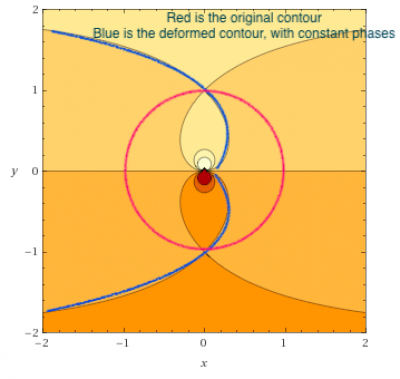2020-03-20, Friday
Today we will continue discussing about the steepest descent method, and its application to finding the asymptotic behavior of special functions.
Bessel function
Recall Bessel function with integer order has the following integral expression. $$ J_n(x) = \oint_{|u|=1} u^{-1-n} e^{\frac{x}{2}(u - 1/u)} \frac{du}{2\pi i} $$
We are interested in the behavior of $J_n(x)$ for $x \gg 1$. This falls into the realm of steepest descent (SD) method,
Aside: Steepest Descent Method
This is about evaluating a contour integral $$ \int_C f(z) e^{\lambda S(z)} dz $$ where $\lambda$ is large, and $f(z), S(z)$ are analytic (may not be everywhere on $\C$, but at least along $C$).
We first look for critical points of $S(z)$, then we deform the contour so that they pass these critical points, then we control the directions that the contour passes through the critical point, to minimize the oscillation of the integrand, i.e choose the contour $C$ near the critical points, so that the integrand has constant phase.
And to leading order, we can replace $f(z)$ by its value at the critical point.
Example Physicists ususally use $1/\hbar$ as $\lambda$. Here are some sample computation. $$ \int_\R e^{-\frac{1}{\hbar} x^2/2} dx = \sqrt{2\pi \hbar} $$ $$ \int_\R x e^{-\frac{1}{\hbar} x^2/2} dx = 0 $$ $$ \int_\R x^2 e^{-\frac{1}{\hbar} x^2/2} dx = \hbar^{3/2} \int_\R u^2 e^{- u^2/2} du = \hbar^{3/2} \sqrt{2\pi} $$ The point is that, having $x^2$ in the pre-factor will make the integral much smaller (indeed, the $x^2$ factor is killing the peak of $e^{-x^2/(2\hbar)}$ at $x=0$.)
Another trick to compute the last equality is that $$ \int_\R x^2 e^{- \lambda x^2/2} dx = -2 \frac{d}{d\lambda} \int_\R e^{- \lambda x^2/2} dx = -2 \frac{d}{d\lambda} \sqrt{2\pi / \lambda} = \sqrt{2\pi} \lambda^{-3/2} $$
Now, back to our Bessel function. We let $x/2$ be the large parameter $\lambda$. Then we have phase function $$ S(u) = u - 1/u. $$
- Critical points of $S(u)$. This is the place where $S'(u)$ vanishes. Compute $$ S'(u) = 1 + 1/u^2, \quad S“(u) = -2/u^3. $$ We get $$S'(u) = 0 \leadsto u = \pm i. $$
- Massage our contour so that they pass through the critical point. Yes, it does, since our contour is the unit circle $|u|=1$.
- Make sure it passes the critical point in the 'right direction'. Now, we need to do Taylor expansion of the phase function $S(u)$ near $\pm i$.
Consider the critical point $u_0=i$ first. For $$u = u_0 + v,$$ we have $$ S(u_0 + v) \approx S(u_0) + (1/2) S''(u_0) v^2 = (i - 1/i) + (1/2) (-2/i^3) v^2 = (2i) - i v^2 $$ The constant term is $2i$, we can do nothing about it, just leave it there. The quadratic term is $ - i v^2$. Recall $v = u - u_0$, as $u$ passes through $u_0$, $v$ passes through $0$. We want to choose the direction in which $v$ passes through $0$, so that $- i v^2$ remains real, and has a local maximum at $v=0$. So we parametrize $$ v = s e^{- i \pi /4}, $$ for $s$ real, that way $$ - i v^2 = - s^2. $$ So the contour $C$ should passes through $i$, in the direction $3\pi/4$( or $-\pi/4$), depending on which way you look).
Thus, the contribution for $u_0 = i$ is $$ \begin{aligned} I_1 &\approx (2\pi i)^{-1} \int_{+\infty}^{-\infty} (i)^{-1-n} e^{(x/2) [(2i) - i v^2]} dv \cr & =(2\pi i)^{-1} (i)^{-1-n} e^{i x} \int_{+\infty}^{-\infty} e^{-(x/2) s^2} d [s e^{- i \pi /4}] \cr & = (2\pi i)^{-1} (-1) (i)^{-1-n} e^{i x - i \pi /4} \int_{-\infty}^{+\infty} e^{-(x/2) s^2} ds \cr & = (2\pi i)^{-1} (-1) e^{i x - i \pi /4 - (n+1) i \pi /2 } \sqrt{2\pi/x} \end{aligned} $$
Similarly, we can compute the contribution at $u_0 = -i$, we get $$ \begin{aligned} I_2 &\approx (2\pi i)^{-1} \int_{-\infty}^\infty (-i)^{-1-n} e^{(x/2) [(-2i) + i v^2]} dv \cr & \approx (2\pi i)^{-1} (-i)^{-1-n} e^{-i x} \int_{-\infty}^{+\infty} e^{-(x/2)s^2} d [s e^{ i \pi /4}] \cr & \approx (2\pi i)^{-1} (-i)^{-1-n} e^{-i x + i \pi /4} \int_{-\infty}^{+\infty} e^{-(x/2) s^2} ds \cr & \approx (2\pi i)^{-1} e^{-i x + i \pi /4 + (n+1) i \pi /2} \sqrt{2\pi/x} \end{aligned} $$
Finally, we can add up the two contributions to get $$ J_n(x) \approx I_1 + I_2 = \sqrt{2/\pi x} \sin(- x + \pi /4 + (n+1) \pi /2) = \sqrt{2/\pi x} \cos(x - (2n+1) \pi /4)$$ where the last step uses trig identity $\sin(A) = \cos(\pi/2 - A)$, so that we agree with Boas.
Here is a picture of the 'ideal contour', where the phase $S(u)$ has 'constant phase'.
 It is made with Wolfram Alpha.
It is made with Wolfram Alpha.
This finishes Chapter 12. I did not talk about the Airy function, Hermite function, Laguerre functions. I will leave those as reading materials, and post homework questions about them.

